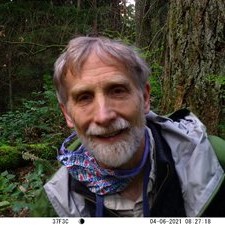David Stokes
Professor

B.A. Geology, Williams College
Ph.D. Zoology, University of Washington
Office: UW1-144
Phone: 425-352-3665
Email: dstokes@uw.edu
Mailing Box: 358530, 18115 Campus Way NE, Bothell, WA 98011-8246
Teaching
I teach courses in the biological realm of environmental science, in subjects such as conservation biology, ecology, and urban ecology, as well as more general courses in environmental studies. In all of my classes, my teaching is motivated by the critical need to improve our understanding of our environment. We are facing conservation and sustainability dilemmas of unprecedented seriousness and complexity. Examples include global climate change and the species extinction crisis. To resolve these issues will require a thorough and rigorous understanding of our earth, its biological systems and components, and the nature of human interaction with those systems and components. I try to develop in students not only a depth of knowledge in a particular subject, but also the critical thinking skills, broad interdisciplinary understanding, and communication skills they will need to effectively address current and future environmental challenges.
Courses
BES 312 Ecology
BES 316 Ecological Methods
BES 485 Conservation Biology
BIS 243 Introduction to Environmental Issues
BIS 390 Ecology and the Environment
BIS 391 Environmental History of the Pacific Northwest Bioregion
BBIO 495/BIS 490 Investigative Biology/Senior Seminar
BCORE 104/110 Discovery Core: Forests and Home
Research/Scholarship
My research addresses topics in the fields of conservation biology, behavioral ecology, urban ecology, and landscape ecology. The ultimate purpose of all of my research is to develop the understanding necessary for more harmonious and equitable co-existence of humans with our natural environment and the other species with which we share that environment.
Currently, my primary research focus is on the role of urbanized landscapes in supporting native species. Since 2018, I and my students have been using wildlife camera traps and other techniques to investigate the presence and activity of native mammal species in parks and green spaces in the urbanized Northshore region of the Seattle metropolitan area. We have found a surprising level of mammal diversity, including a robust mesopredator community, as well as high diversity of native birds and plant species. In 2021 I expanded this project to include investigation of wildlife outside of parks and green spaces with a citizen science project in which members of the community manage wildlife cameras to monitor wildlife in the neighborhoods where they live. Through all of this work we are trying to learn how do native species use urban habitats, what makes good habitat for urban wildlife, what aspects of urbanization are most threatening to wildlife persistence, and how we might design or manage the areas where we live to better accommodate the needs of native species. This work has implications not only for conservation of species, but quality of life and environmental equity for humans.
I am also pursuing research on the ecology and conservation of an endangered salamander species that inhabits a rapidly urbanizing area of California, and the ecological impacts and patterns of spread of non-native invasive tree species in Pacific Northwest forests. Additional research interests include topics in behavioral ecology such as habitat selection and migratory behavior in penguins, land-use planning and biodiversity conservation, GIS-based conservation planning, human biodiversity preferences, the relationship between urban biodiversity conservation and human environmental equity, and the role of the concept of wildness in conservation. Most of my research is field-oriented, and makes use of both high- and low-tech techniques. I welcome participation in my research by graduate students and undergraduates.
Selected Publications
- Stokes, D.L., Messerman, A.F., Cook, D.G., Stemle, L., Meisler, J.A., and C.A. Searcy. 2021. Saving all the pieces: an inadequate conservation strategy for an endangered amphibian in an urbanizing area. Biological Conservation 262 (2021) 109320.
- Stokes, D.L. 2018. Why conserving species in the wild still matters. Biodiversity and Conservation 27:1539–1544.
- Stokes, D.L., Church, E.D., Cronkright, D.M., and S. Lopez. 2014. Pictures of an invasion: English Holly (Ilex aquifolium) invasion of a Pacific Northwest forest. Northwest Science 88:75-93.
- Stokes, D.L., Boersma, P. D., Lopez de Casenave, J., and P. García-Borboroglu. 2014. Long-distance migration of Magellanic penguins requires marine zoning for conservation. Biological Conservation 170:161-171.
- Stokes, D.L., Hansen, M.F., Oaks, D.D., Straub, J.E., and A.V. Ponio. 2010. Biodiversity conservation in local land-use planning: what planners can tell us about what works. Conservation Biology 24:450-560.
- Stokes, D.L. 2007. Things we like: Human preferences among similar organisms and implications for conservation. Human Ecology 35: 361-369.
- Stokes, D. L. 2006. Conservators of experience. BioScience 56: 6-7.
- Stokes, D.L., and P.H. Morrison. 2003. GIS-based conservation planning: a powerful tool… to be used with care. Conservation in Practice 4: 38-41.
- Stokes, D.L., and P.D. Boersma. 2000. Nesting density and reproductive success of a colonial seabird. Ecology 81: 2878-2891.